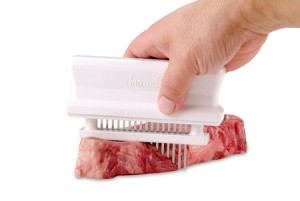I don’t order steaks at restaurants very often; it’s not for safety reasons, it’s because I can buy good ribeye or fillet and grill it at home.
About once a week I make a spinach salad with pears, blue cheese and toasted walnuts served with sliced steak. I like to sear the outside to about 220F – and keep the inside around 130F. Something I can do with little risk if my meat is fully intact.
I don’t buy mechanically tenderized meat.
At least I don’t think I do. As a consumer, up until now I’ve been at the mercy of the butcher/meat counter. I ask questions. Folks tell me it’s not tenderized.
Soon, I’ll be able to look for a label. According to Meating Place, USDA FSIS’s final rule on mechanically tenderized beef labeling was just released.
The rule was two years in the making and requires that the product names of the affected products include the descriptive designation “mechanically tenderized,” “blade tenderized” or “needle tenderized.” Raw products that are destined for foodservice or home cooking have to include cooking instructions that recommend that mechanically tenderized beef be cooked to a minimum internal temperature of 145 degrees followed by a three-minute rest time.
The new rule is intended to address issues with the blades or needles used to mechanically tenderized meat cuts, which can introduce pathogens from the surface of the meat into the interior. If not fully cooked, then, the pathogens could make diners sick the same way a rare or medium rare burger can.
Consumers have been getting messages about fully cooking their burgers, however, whereas they are more likely to cook mechanically tenderized steak on the rare side, the same they way would with an intact cut.
About 11 percent, or 2.6 billion pounds, of beef products sold in the U.S. have been mechanically tenderized, according to USDA data. Deputy Undersecretary Al Almanza said the new rule comes in response to six outbreaks of illnesses linked to bacterial contamination in mechanically tenderized meat since 2000.
